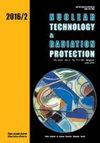Design of array switching circuit for multiplex nuclear pulse signal
IF 0.9
4区 工程技术
Q3 NUCLEAR SCIENCE & TECHNOLOGY
引用次数: 1
Abstract
Commercial multi-channel energy spectrometers have good performance, they have multiple input signal channels and multi-channel analyzers, which can simultaneously acquire the energy spectrum of multiple nuclear pulse signals. But the input signal channel of this general multi-channel energy spectrometer cannot be switched between the internal multi-channel analyzers, and an input signal channel can only be fixed to the corresponding multi-channel analyzers. Hence, to resolve this issue, this paper designed a nuclear pulse signal array switching circuit. The core of the array switching circuit is a switch array chip with low internal resistance and high bandwidth, which controls the signal connection between the input signal channel with the multi-channel analyzers. Using 137Cs and uranium ore as radioactive sources, the energy spectrum test and spectrum data analysis were carried out using a NaI detector, respectively, when the nuclear pulse signal passed through and did not pass through the array switching circuit. The results showed that the circuit demonstrates little effect on the energy resolution and linearity of the multi-channel analyzers but causes a small drift of the high-energy photopeak, and improve the reliability of the circuit by energy spectrum data accumulation. This circuit can make the application of a multi-channel energy spectrometers more flexible and reliable.多路核脉冲信号阵列开关电路的设计
商用多通道能谱仪具有良好的性能,它具有多通道输入信号和多通道分析仪,可以同时获取多个核脉冲信号的能谱。但这种通用多通道能谱仪的输入信号通道无法在内部多通道分析仪之间切换,只能将一个输入信号通道固定到相应的多通道分析仪上。因此,为了解决这一问题,本文设计了一种核脉冲信号阵列开关电路。阵列开关电路的核心是一个低内阻、高带宽的开关阵列芯片,控制输入信号通道与多通道分析仪之间的信号连接。以137Cs和铀矿石为放射源,分别在核脉冲信号通过阵列开关电路和未通过阵列开关电路时,利用NaI探测器进行能谱测试和光谱数据分析。结果表明,该电路对多通道分析仪的能量分辨率和线性度影响不大,但使高能光峰漂移较小,并通过能谱数据积累提高了电路的可靠性。该电路可使多通道能谱仪的应用更加灵活可靠。
本文章由计算机程序翻译,如有差异,请以英文原文为准。
求助全文
约1分钟内获得全文
求助全文
来源期刊

Nuclear Technology & Radiation Protection
NUCLEAR SCIENCE & TECHNOLOGY-
CiteScore
2.00
自引率
41.70%
发文量
10
审稿时长
6-12 weeks
期刊介绍:
Nuclear Technology & Radiation Protection is an international scientific journal covering the wide range of disciplines involved in nuclear science and technology as well as in the field of radiation protection. The journal is open for scientific papers, short papers, review articles, and technical papers dealing with nuclear power, research reactors, accelerators, nuclear materials, waste management, radiation measurements, and environmental problems. However, basic reactor physics and design, particle and radiation transport theory, and development of numerical methods and codes will also be important aspects of the editorial policy.
 求助内容:
求助内容: 应助结果提醒方式:
应助结果提醒方式:


